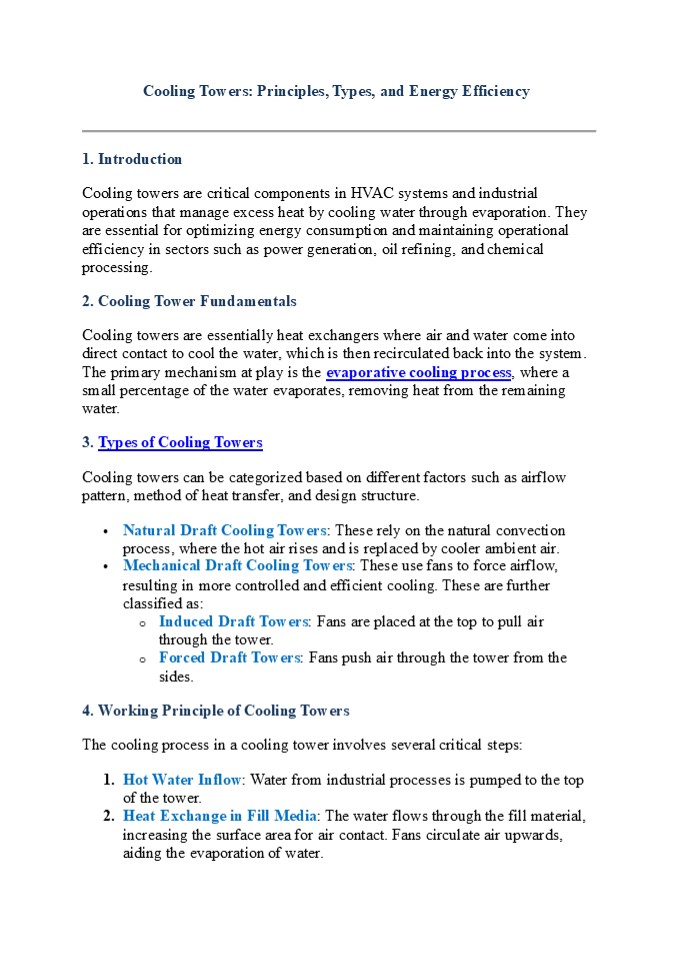Cooling Towers Principles - PowerPoint PPT Presentation
Title:
Cooling Towers Principles
Description:
Cooling towers are critical components in HVAC systems and industrial operations that manage excess heat by cooling water through evaporation. They are essential for optimizing energy consumption and maintaining operational efficiency in sectors such as power generation, oil refining, and chemical processing. – PowerPoint PPT presentation
Number of Views:2
Title: Cooling Towers Principles
1
Cooling Towers Principles, Types, and Energy
Efficiency
- Introduction
- Cooling towers are critical components in HVAC
systems and industrial operations that manage
excess heat by cooling water through evaporation.
They are essential for optimizing energy
consumption and maintaining operational
efficiency in sectors such as power generation,
oil refining, and chemical processing. - Cooling Tower Fundamentals
- Cooling towers are essentially heat exchangers
where air and water come into direct contact to
cool the water, which is then recirculated back
into the system. The primary mechanism at play
is the evaporative cooling process, where a
small percentage of the water evaporates,
removing heat from the remaining water. - Types of Cooling Towers
- Cooling towers can be categorized based on
different factors such as airflow pattern,
method of heat transfer, and design structure. - Natural Draft Cooling Towers These rely on the
natural convection process, where the hot air
rises and is replaced by cooler ambient air. - Mechanical Draft Cooling Towers These use fans
to force airflow, - resulting in more controlled and efficient
cooling. These are further classified as - Induced Draft Towers Fans are placed at the top
to pull air through the tower. - Forced Draft Towers Fans push air through the
tower from the sides. - Working Principle of Cooling Towers
- The cooling process in a cooling tower involves
several critical steps - Hot Water Inflow Water from industrial processes
is pumped to the top of the tower.
2
- Evaporation A small portion of the water
evaporates, and the heat is dissipated into the
air. This cools the remaining water, which is
then collected in a basin at the bottom. - Cooling Water Outflow The cooled water is pumped
back into the - system for reuse.
- Types of Cooling Tower Circulation
- Open Loop Systems In open-circuit towers, water
is directly exposed to the air. A portion of the
water evaporates, causing a loss that needs
replenishment. - Closed Loop Systems In these systems, water
flows through a closed - loop, preventing exposure to outside air, and
cooling is achieved through a secondary circuit.
3
- Drift Losses, Water Consumption, and Makeup Water
- Drift Losses Drift eliminators are used in
cooling towers to capture water droplets and
reduce the amount lost to the atmosphere. - Water Consumption Water loss occurs due to
evaporation, drift, and - blowdown (the removal of dissolved solids).
- Makeup Water To replace evaporated water and
maintain the correct water levels, makeup water
is required. This is a crucial factor in
maintaining the operation efficiency of cooling
tower
4
7. Energy-Efficient Cooling Towers Energy-efficien
t cooling towers focus on minimizing water loss
and optimizing heat exchange processes. Advances
in fan technology, drift eliminators, and water
treatment systems have led to the development of
high-efficiency cooling towers.
8. Conclusion The importance of cooling towers
in industrial and commercial applications cannot
be understated. With the growing need for energy
efficiency and sustainable water usage,
innovations in cooling tower design and operation
continue to evolve, making them more critical in
the global push toward greener technologies.































